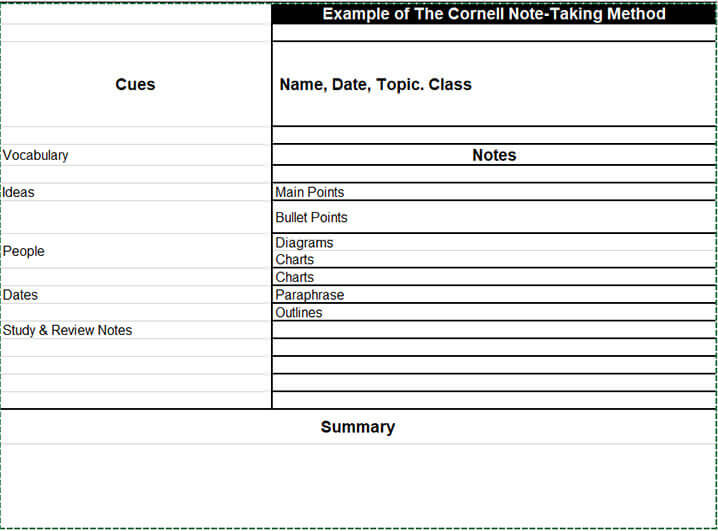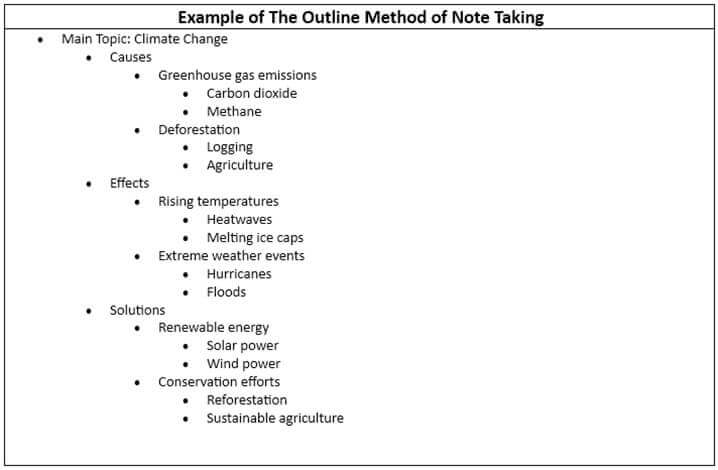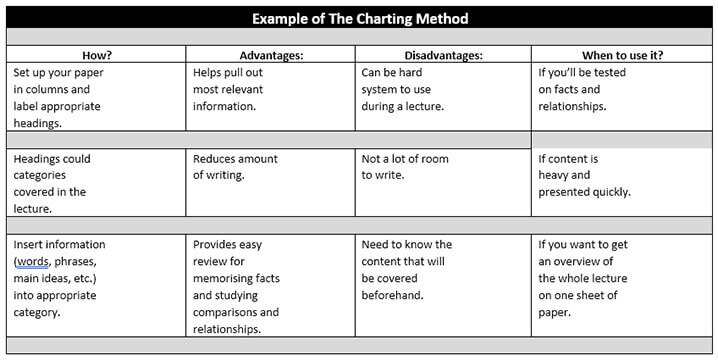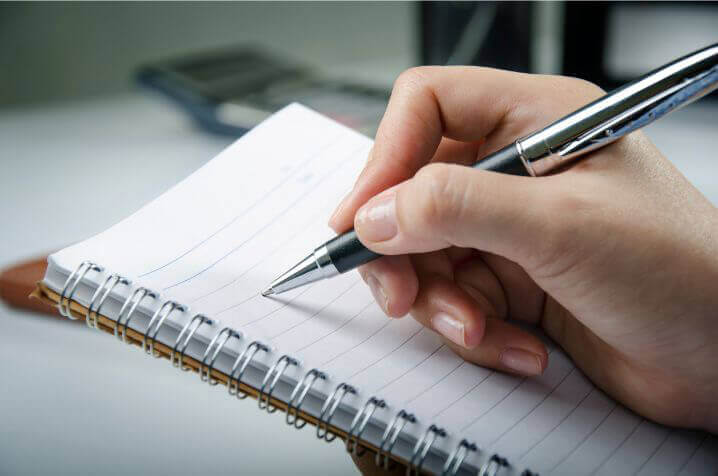In today’s fast-paced world, efficiency is vital, and speed writers constantly seek ways to write faster to improve their productivity.
One crucial aspect of fast, effective writing is taking clear, concise, and organized notes.
Whether attending a lecture, participating in a meeting, or just reading through materials, having a reliable note-taking method can make all the difference.
In this guide, we’ll show you the top 5 note-taking methods speed writers use to write faster, delving into their unique benefits and providing tips on how to make the most of each technique.
By mastering these methods, you’ll be well on your way to enhancing your writing speed and overall efficiency.
Table of Contents
- 1. Cornell Method
- 1.1. Brief History and Purpose
- 1.2. How to Use the Cornell Method
- 1.3. Note Taking Benefits
- 1.4. Cornell Method Templates
- 2. Outline Method
- 2.1. Description of the Method
- 2.2. Tips for Creating Effective Outlines
- 2.3. Why Note-takers Should Consider Using the Outline Method
- 3. Mind Mapping
- 3.1. Concept and Origin
- 3.2. Steps to Create a Mind Map
- 3.3. Advantages of Mind Mapping in Organizing and Remembering Information
- 4. Charting Method
- 4.1. Explanation of the Method
- 4.2. Best Practices For Creating Effective Charts
- 4.3. Reasons You Should Adopt the Charting Method
- 5. Sentence Method
1. Cornell Method

1.1. Brief History and Purpose
The Cornell Method, also known as the Cornell Note-taking System, was developed by Dr. Walter Pauk in the 1950s at Cornell University.
Dr. Pauk, an education professor, designed this system to help students take organized, concise notes that would enhance their learning and retention of information.
The purpose of the Cornell Method is to facilitate better comprehension, review, and summarization of the material covered in lectures, readings, or presentations.
1.2. How to Use the Cornell Method
To use the Cornell Method, follow these steps:
- Divide your paper into three sections:
- Draw a vertical line about 2.5 inches from the left edge of the paper, creating a narrow column.
- Draw a horizontal line about 2 inches from the bottom, creating a smaller section.
- Record notes in the largest section (right column):
- Write down the main ideas, facts, and details during lectures or reading.
- Use abbreviations, symbols, and bullet points for faster note-taking.
- Write keywords and cues in the left column:
- After the lecture or reading, review your notes and identify the main concepts.
- Write a keyword or cue in the left column next to the corresponding information in the right column.
- Summarize the material in the bottom section:
- After reviewing your notes, summarize the main ideas briefly in your own words.
- It will help solidify your understanding and make it easier to review the material later.
1.3. Note Taking Benefits
The Cornell Method offers several benefits for speed writers looking to take notes quickly:
- Efficiency: The structured format allows quick, organized note-taking, enabling you to keep up with fast-paced lectures or discussions.
- Review: The cues and summary sections make it easier to review the material, saving time when preparing for exams or revisiting notes.
- Comprehension: You can better understand and retain the information by engaging with the material through summarization and identifying keywords.
- Flexibility: The Cornell Method can be adapted for various subjects and disciplines, making it a versatile note-taking tool for speed writers.
1.4. Cornell Method Templates
If you prefer a template, you can use a Google Docs Cornell Template, or there are plenty of Cornell notebooks on Amazon.
Buy Cornell Method Notebooks on Amazon
2. Outline Method

2.1. Description of the Method
The Outline Method is a hierarchical note-taking system that uses indentation and bullet points or numbers to organize information visually.
It’s based on breaking down complex topics into smaller, more manageable subtopics, allowing for a clear and structured representation of the material.
The method is particularly useful for capturing the relationships between ideas, making it easier to grasp and remember the content.
2.2. Tips for Creating Effective Outlines
To create an effective outline, follow these tips:
- Start with a main topic: Begin by identifying the central idea, concept, or theme of the material you’re learning. Write it at the top of your page as the main heading.
- Identify subtopics: Break down the main topic into smaller, related subtopics. Write these as subheadings, indented beneath the main heading. Use bullet points, numbers, or letters to differentiate levels of hierarchy.
- Add supporting details: Under each subheading, list relevant information, examples, or facts that support the subtopic. Indent further to visually distinguish these details from the subheadings.
- Use consistent formatting: Choose a clear and consistent format for your headings, subheadings, and supporting details. It will make your outline easy to follow and understand.
- Revise and refine: Review your outline and make necessary adjustments to improve clarity and organization. Ensure that your outline accurately captures the relationships between ideas.
2.3. Why You Should Consider Using the Outline Method For Note Taking
Note-Takers can benefit from the Outline Method for several reasons:
- Clarity and organization: The hierarchical structure of the Outline Method promotes clear, logical organization, making it easier for speed writers to quickly capture complex ideas and their relationships.
- Efficiency: The concise format of the Outline Method enables writers to take notes more rapidly while maintaining the essential information and connections between ideas.
- Retention and comprehension: you can better understand and remember the material by breaking down complex topics into smaller, manageable pieces.
- Flexibility: The Outline Method is adaptable to various subjects and disciplines, providing speed writers with a versatile and effective note-taking tool.
- Review and revision: Outlines can be quickly reviewed, revised, and expanded upon, making them an efficient study aid.Top of Form
3. Mind Mapping

3.1. Concept and Origin
Mind mapping is a visual note-taking technique that uses diagrams to represent ideas, concepts, and their relationships.
Developed by British psychologist Tony Buzan in the 1970s, mind mapping encourages creativity and non-linear thinking, making it an effective tool for brainstorming, problem-solving, and memory retention.
It involves creating a central node representing the main topic and then branching out to related subtopics, with further branching for supporting details.
3.2. Steps to Create a Mind Map
To create a mind map, follow these steps:
- Start with a central topic: Write down the main idea or concept in the center of a blank page, and draw a circle or other shape around it.
- Add branches for subtopics: From the central topic, draw lines outward to represent related subtopics. Label each line with a keyword or phrase that describes the subtopic.
- Expand with supporting details: For each subtopic, add additional lines or branches to include relevant information, examples, or ideas. Use colors, symbols, or images to visually differentiate and emphasize these details.
- Organize and structure: Arrange your branches and sub-branches logically and meaningfully. Connect related ideas with lines or arrows to indicate relationships between them.
- Personalize and refine: Customize your mind map with colors, images, and personal symbols that resonate with you. Review and revise your mind map as needed to ensure clarity and completeness.
3.3. Advantages of Mind Mapping in Organizing and Remembering Information
Mind mapping offers several advantages in remembering information.
- Enhances creativity: Mind mapping stimulates creative thinking by encouraging non-linear connections between ideas, which can lead to new insights and discoveries.
- Increases efficiency: The visual nature of mind maps allows speed writers to capture and organize information more quickly than with traditional linear notes.
- Improves memory retention: By associating ideas with visual elements such as colors, symbols, and images, mind mapping enhances memory recall and comprehension.
- Facilitates problem-solving: Mind maps can help speed writers identify patterns, relationships, and gaps in knowledge, making them useful for problem-solving and decision-making.
- Adaptable and versatile: Mind mapping can be used for various purposes, including brainstorming, planning, organizing, and studying, making it a valuable tool for speed writers in many contexts.Top of Form
4. Charting Method

4.1. Explanation of the Method
The Charting Method is a note-taking technique that uses tables, graphs, or other visual representations to organize and display information.
This method is beneficial for capturing complex, data-heavy, or hierarchical information clearly and concisely.
By presenting information visually, the Charting Method simplifies the process of understanding and analyzing intricate concepts, making it easier to grasp and retain the material.
4.2. Best Practices For Creating Effective Charts
To create effective charts using the Charting Method, follow these guidelines:
- Choose the appropriate format: Select the most suitable chart type (e.g., table, bar graph, flowchart) based on the nature of the information you’re dealing with.
- Organize the data: Arrange your data in a logical, easy-to-understand manner, using columns, rows, or sections as needed. Clearly label each part of the chart to provide context.
- Use visuals and colors: Incorporate visual aids such as icons, symbols, or color coding to emphasize key points and differentiate between data elements.
- Please keep it simple: Avoid clutter and unnecessary detail in your charts, focus on essential information, and strive for clarity and readability.
- Update and revise as needed: As new information becomes available or your understanding of the topic evolves, be prepared to update and refine your charts accordingly.
4.3. Reasons You Should Adopt the Charting Method
The Charting Method offers several benefits for speed writers:
- Enhances information processing: By presenting information visually, the Charting Method makes it easier for speed writers to comprehend and analyze complex concepts and data.
- Improves memory retention: The use of visual aids and organized data in charts can facilitate better recall and understanding of the material.
- Saves time: The Charting Method allows speed writers to quickly capture and organize information, reducing the time spent on note-taking and making it easier to review the material later.
- Encourages active learning: Creating charts requires active engagement with the material, promoting a more profound understanding and long-term retention of the information.
- Versatility: The Charting Method can be applied to various subjects and scenarios, making it a valuable tool for writers in multiple contexts.Top of Form
5. Sentence Method

5.1. Overview and Purpose
The Sentence Method is a straightforward note-taking technique that involves writing concise, complete sentences to capture key points, ideas, or facts.
This method helps maintain clarity and focus while taking notes and accurately represents the main ideas.
By using complete sentences, speed writers can create notes that are easy to review and understand, making this method a practical option for various situations.
5.2. Tips for Speed Writing using the Sentence Method
- Be selective: Focus on capturing the most important and relevant information rather than trying to write down everything. It will help you maintain speed and focus on the main ideas.
- Keep sentences brief and clear: Use concise language and avoid overly complex sentences. Short, clear sentences are easier to read and review later.
- Use abbreviations and symbols: Use commonly accepted ones to save time and maintain your writing speed.
- Paraphrase when appropriate: Instead of copying information verbatim, try to put it in your own words, which can help with comprehension and retention.
- Stay organized: Arrange your sentences logically, grouping related ideas for easier review and understanding.
5.3. When to Use the Sentence Method for Maximum Efficiency
The Sentence Method is most effective in the following situations:
- Lectures and presentations: When listening to a speaker, the Sentence Method allows you to quickly capture the main points and ideas in an organized manner.
- Reading materials: As you read through books, articles, or other materials, using the Sentence Method can help you identify and record the key takeaways efficiently.
- Meetings and discussions: During group discussions or meetings, the Sentence Method enables you to jot down important statements and decisions without missing critical details.
- Brainstorming and planning: When working on a project or planning a task, the Sentence Method can help you outline your ideas and goals in a clear, concise format.
- Situations requiring precision: In contexts where accuracy and detail are essential, the Sentence Method ensures you capture complete and precise information for later reference.Top of Form
5.4. Conclusion
In conclusion, finding the note-taking method best suited for your unique needs as a speed writer can significantly boost your productivity and ensure you capture essential information effectively.
By exploring the Cornell Method, Outline Method, Mind Mapping, Charting Method, and Sentence Method, you can discover the best technique for you and enhance your ability to organize and remember information.
Remember, practice makes perfect – so don’t be afraid to experiment with these methods and fine-tune your skills.
Don’t forget that the type of pen you use can make a difference in how fast you can write. Check out our guide, The Best 3 Pens for Fast Handwriting, to find your perfect pen.
With dedication and persistence, you’ll be well-equipped to tackle any note-taking challenge improve your wring speed, and excel as a speed writer.
Further Reading
Speed Writing Essentials: Choosing the Perfect Pen
Are you a Slow Writer? – Write Faster and Neater in 6 Simple Steps
References
